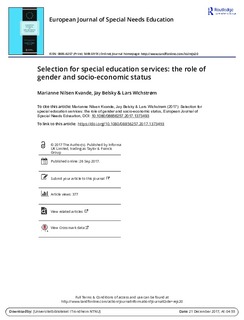| dc.contributor.author | Kvande, Marianne N. | |
| dc.contributor.author | Belsky, Jay | |
| dc.contributor.author | Wichstrøm, Lars | |
| dc.date.accessioned | 2017-12-22T13:46:48Z | |
| dc.date.available | 2017-12-22T13:46:48Z | |
| dc.date.created | 2017-12-21T13:52:03Z | |
| dc.date.issued | 2017 | |
| dc.identifier.citation | European Journal of Special Needs Education. 2017. | nb_NO |
| dc.identifier.issn | 0885-6257 | |
| dc.identifier.uri | http://hdl.handle.net/11250/2473719 | |
| dc.description.abstract | Children from some demographic groups disproportionately receive special education (SE) services. Due to methodological shortcoming in existing work, it remains unclear whether this is due to real differences in academic needs or cultural selection/bias. Hence, in a community sample of 1250 Norwegian children, we examined the role of third grade SE services, academic test scores, behavioural problems, and teacher’s level of helplessness in mediating the effect of family socio-economic status (SES) and students’ gender on fifth-grade SE services. Results revealed no direct effects of either gender or SES on fifth-grade SE, but four mediated pathways were identified: (1) Boys had a greater likelihood of receiving fifth-grade SE services when (a) they previously received SE and (b) they experienced more ADHD symptoms, both in third grade. (2) Students from low-SES families were more likely to receive SE services in fifth grade when (a) they performed poorly in math in third grade and (b) their teacher reported greater feelings of helplessness when teaching these students. The findings are discussed with respect to the differential-needs hypothesis, mechanisms of cultural selection and the possibility of gendered selection for SE at younger ages. | nb_NO |
| dc.language.iso | eng | nb_NO |
| dc.publisher | Taylor & Francis Group | nb_NO |
| dc.rights | Attribution-NonCommercial-NoDerivatives 4.0 Internasjonal | * |
| dc.rights.uri | http://creativecommons.org/licenses/by-nc-nd/4.0/deed.no | * |
| dc.title | Selection for special education services: the role of gender and socio-economic status | nb_NO |
| dc.type | Journal article | nb_NO |
| dc.type | Peer reviewed | nb_NO |
| dc.description.version | publishedVersion | nb_NO |
| dc.source.journal | European Journal of Special Needs Education | nb_NO |
| dc.identifier.doi | 10.1080/08856257.2017.1373493 | |
| dc.identifier.cristin | 1531042 | |
| dc.description.localcode | © 2017 The Author(s). Published by Informa UK Limited, trading as Taylor & Francis Group This is an Open Access article distributed under the terms of the Creative Commons Attribution-NonCommercial-NoDerivatives License (http://creativecommons.org/licenses/by-nc-nd/4.0/), which permits non-commercial re-use, distribution, and reproduction in any medium, provided the original work is properly cited, and is not altered, transformed, or built upon in any way. | nb_NO |
| cristin.unitcode | 194,67,40,0 | |
| cristin.unitname | Institutt for psykologi | |
| cristin.ispublished | true | |
| cristin.fulltext | original | |
| cristin.qualitycode | 2 | |

